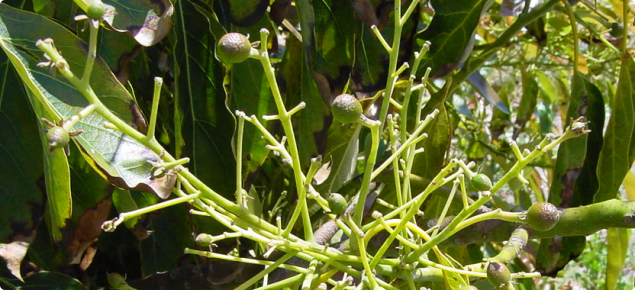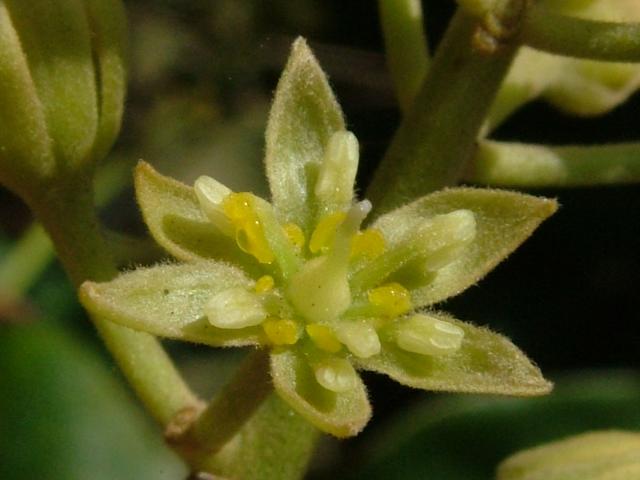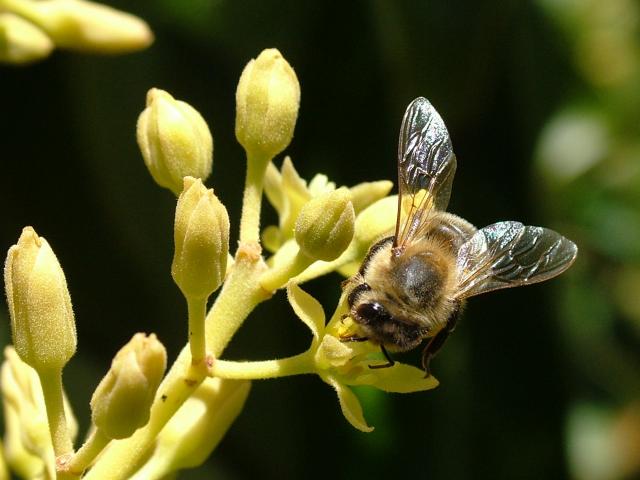Flowering and pollination
A mature avocado tree may produce in excess of a million flowers during the flowering period, most of which fall without producing fruit. The purpose behind the mass flowering is to encourage visits by pollen vectors. In the wild this means a range of flying and crawling insects, but in Western Australia this is believed to be mainly the European honey bee.
The avocado has a ‘complete’ flower, but with an unusual behaviour known as ‘protogynous dichogamy’. The avocado flower has both functional male and female organs in the one flower, but opens and closes twice over a two-day period — the first day as functionally female (Figure 1) and the next as functionally male (see Figure 2). Each opening stage only lasts about half a day.
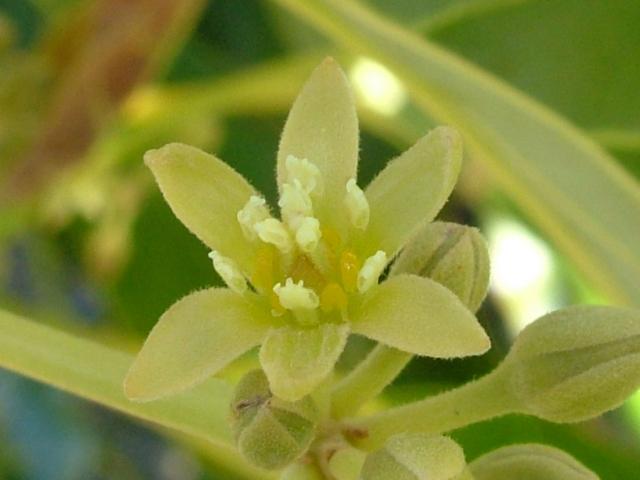
In general, on a single tree all the open flowers will be synchronised. That means they will be all functionally male or all functionally female. The avocado pollen of one tree is compatible with itself and quite capable of pollinating its own flowers — known as self-pollination. The unusual flowering behaviour is to reduce the likelihood of this occurring — by minimising the amount of own-pollen about when female stages are receptive.
To further maximise the likelihood of cross-pollination some trees will open first in the morning as functionally female, close and then reopen the next afternoon as functionally male (type A flowering sequence).
Other trees open first in the afternoon as functionally female, close and then reopen the next morning as functionally male (type B flowering sequence).
The timing of these stages determines the classification of varieties into either type A or B flowering. See Table 1 for a diagram of the opening sequence of type A and B flowering varieties and how this sequence promotes cross-pollination. This is an evolutionary development to increase genetic diversity.
It is important to understand that as a ‘clonally’ produced tree, a stand of a single variety such as Hass will flower essentially as a single tree. That is, all trees will display the same flowering type behaviour. Table 2 lists some of the common varieties and their flowering types.
| Flower type | Day 1 Morning | Day 1 Afternoon | Day 2 Morning | Day 2 Afternoon |
|---|---|---|---|---|
| A | female | closed | closed | male |
| B | closed | female | male | closed |
| Flower type A | Flower type B |
|---|---|
| Anaheim | Bacon |
| Gwen | Edranol |
| Hass | Ettinger |
| Hazzard | Fuerte |
| Lamb Hass | Llanos Hass |
| Pinkerton | Nabal |
| Reed | Nobel |
| Rincon | Sharwil |
| Wurtz | Shepard |
| — | Zutano |
Cross-pollination for good fruit set?
In the normal sequence of events, the avocado tree will produce large numbers of flowers with some beginning their opening sequence every day. Because a single flower takes two days to complete its cycle, on any one day some flowers will be opening as female and others as male, just at different times of the day.
The stigma of an avocado flower will normally have ceased to be receptive to pollen when it starts to release its own pollen. However, as a result of the mass flowering, you will notice from Figure 3 that under ideal temperatures (maximum 25°C, minimum 20°C) there is theoretically some overlap from other flowers providing a small window of opportunity for what is termed close-pollination. Figure 4 provides real-life example of the cross-over event.
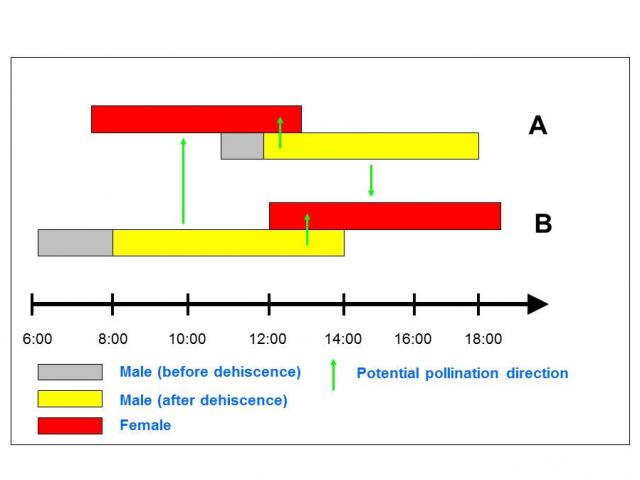
Based on this, many avocado orchards have been planted with Hass only. However, recent research into increasing avocado production per hectare has been highlighting the benefits of increasing the period of potential pollination by inter-planting with complementary varieties, for example, a type B flowering variety in your Hass orchard.
This is particularly the case if you are in colder locations, or using management practices that compress the period of flowering, such as the use of plant growth regulators or ‘scoring’.
This is not a case of just selecting a variety with a known complementary flowering type to your main variety. Different varieties not only have either type A or B flowering behaviour, they can also flower at slightly different periods during the year.
While the opening and closing of flowers over the two-day cycle is synchronised, it is also affected by air temperature. Under stable ‘ideal’ flowering temperatures (maximum 25°C, minimum 20°C), the flowers behave much like the typical pattern shown in Figure 3. But Under cooler conditions (maximum 20°C, minimum 10°C), flower opening can be both delayed and extended, as shown in Figure 5.
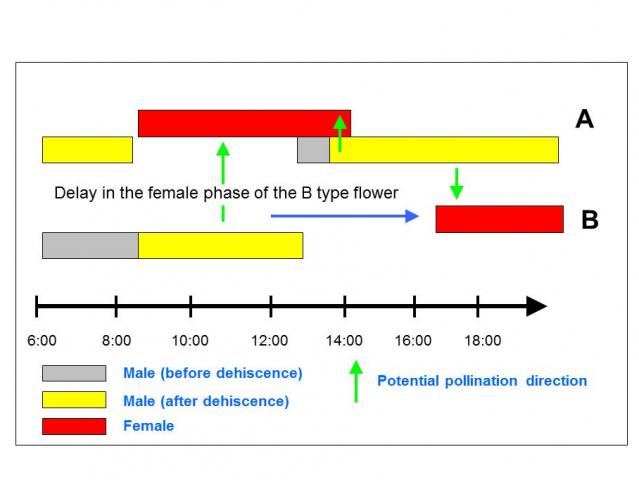
Under even colder conditions, type B flowers may be delayed so much that the female stage may not be detected, with the flower appearing to open only as a functional male.
Also, the male phase of type A flowers may be so delayed that they remain open over-night and into the next morning.
The temperature effect on flower opening is not necessarily equal on all varieties. Temperatures in the South-West are frequently well below ideal. As a result of differences for each variety and the importance of achieving complementary flowering between your main variety (most commonly Hass) and chosen polliniser, it is beneficial to monitor the flowering patterns of a range of varieties to determine the best fit under your conditions.
Identifying better polliniser varieties
In 2009 the flowering of a range of type B avocado varieties was monitored in the South-West of Western Australia to find how closely they flower in relation to Hass (Table 3).
This information was based on a single year of observations. While flowering over the same timeframe does not guarantee they are good pollinisers because they need to open in synergy under prevailing climatic conditions, it is a reasonable starting guide.
For a more detailed report, see ‘Investigating suitable cross-polliniser varieties for Hass avocado’.
| Variety | Flower timing in relation to Hass |
|---|---|
| Edranol (trees less than four years old) | Good |
| Zutano (trees less than four years old) | Good |
| Ettinger (trees less than four years old) | Slightly earlier |
| Sharwil | Slightly earlier |
| Bacon | Earlier |
| Fuerte | Earlier |
| Shepard | Earlier |
Polliniser spacing
For pollinisers to have the maximum effect they should be of similar numbers to the complementary variety and evenly spaced within the orchard. However, often the polliniser variety is not preferred for markets, or in cooler locations might not yield well if they are type B.
As such, you do not want large numbers of trees producing unpopular or very little fruit as this is inefficient use of land, water, resources and labour. If you cannot identify a suitable polliniser that produces fruit in demand and of acceptable quantities, then aim to plant as few as possible to achieve acceptable cross-pollination.
The planting pattern of the polliniser variety depends on how the pollen is expected to move from the polliniser tree to the main variety.
In Western Australia, the European honey bee is the main pollinator. There has been quite a deal of research monitoring the habits and movements of the European honey bee. While there is still debate over the best planting ratio, one in nine is common, with trees evenly spaced within the orchard to minimise the distance between polliniser trees and the main variety.
A polliniser tree is located at every third space in every third row (Figure 6). An alternative pattern is a one in eight planting ratio, particularly for hedge row planting to provide line of sight to a polliniser for all walls of foliage, so pollinator bees do not have to move through a wall of foliage. A polliniser tree is located at every fourth space in every second row (Figure 7).
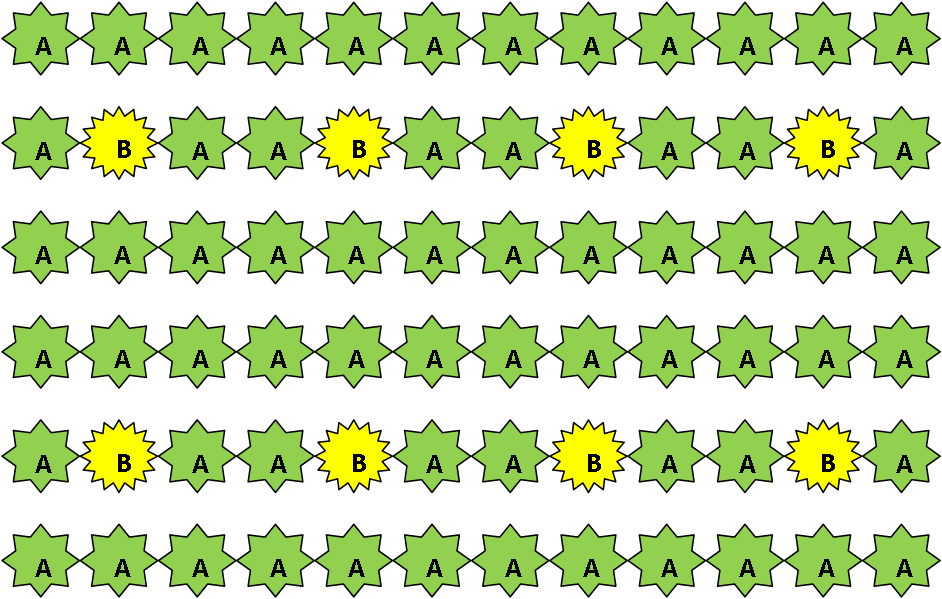
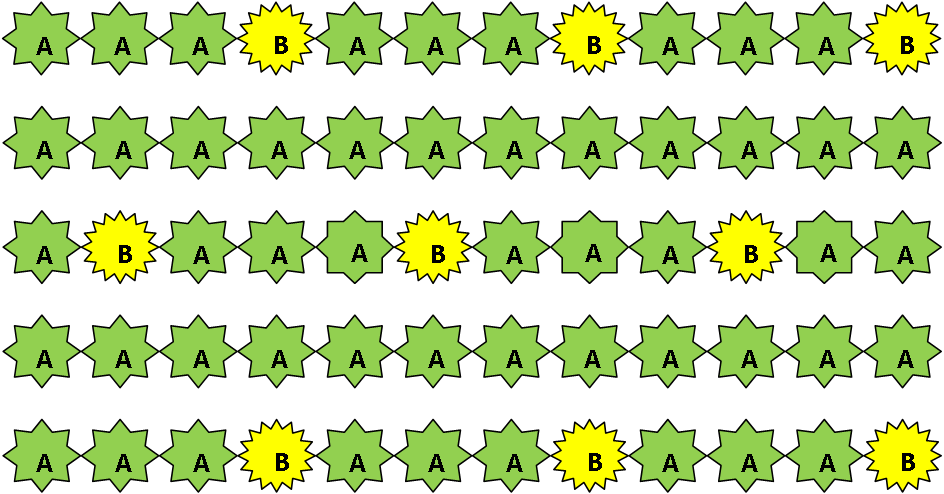
Do we need pollinators?
Yes. The separation in time of the male and female phases of a single flower and the nature of avocado pollen has led most observers to believe that a pollen vector or ‘pollinator’ is needed to move pollen from one flower to another.
While there is some speculation on the capacity of a range of small insects (including the hover fly) to act as pollinators, the European honey bee (Figure 8) is by far the most recognised and commonly used pollinator in Western Australia. The honey bee is also the only insect that is commercially farmed and sold for pollination services in Western Australia.
The avocado flower provides both pollen and nectar which will attract the bees, but due to its size, unusual opening sequence and lower sugar concentration in its nectar, it is not preferred by honey bees. In fact the ancestral pollinators of avocados were small stingless wasps and flies. Therefore, while resident populations of feral bees will visit your avocado trees and do pollination work, they will often be attracted more to other plants flowering at the same time, thus limiting their effectiveness.
Bees are known to scout an area and learn where preferred plants are and target these. New bees to an area will not have this knowledge and will target the closest flowers initially, gradually building their knowledge. To maximise pollination of your avocados, it is preferable to bring in fresh hives at the start of flowering (ideally once roughly 10% of flowers have opened). Do not bring in hives too early as the bees will find other flowers to visit (eg. Capeweed, Wild Radish, other wildflowers), and even when the avocado trees begin to flower in earnest, the bees will remain preferential to the first flowers they found when they were moved into the area.
The introduction of bee hives into an orchard for pollination requires some planning. It is preferable to bring in healthy and active hives that are going to be collecting both pollen and nectar. This is usually done through the services of a professional pollination provider, who will condition hives and transport them to your orchard at an agreed time.
As conditioning hives takes time, and flowering can go from 10 to 80% opened in less than a week, you need to plan in advance with your pollination provider.
The placement of the bee hives within the orchard also needs to be considered. They are best placed in small groupings relatively evenly scattered within the blocks flowering, at a rate of two to five hives per hectare. Do not place the hives on the outside of the blocks as the scout bees might find alternative flowers faster and ignore your avocado trees.
Bees are also living insects, so absolute care needs to be taken about the choice and use of any chemical that may be applied to the orchard during flowering. If required, always choose the chemical with the lowest bee toxicity and apply in the evening when bees are less active.
If a bee-toxic chemical is required, you should liaise with the pollination provider about removing the bees for a few days. Thankfully, avocado production in Western Australia requires minimal pesticide use, so it is unlikely to be a common issue.
Fruit set
The avocado tree is noted for having large numbers of flowers in some seasons and yet setting very light crops. There is a range of factors that affect fruit set. Initially there is the requirement for pollen to be transferred onto the stigma (female parts) of the flower while it is receptive, as discussed earlier.
Research has found that increasing the number of pollen grains deposited onto a receptive stigma will increase the likelihood of effective pollination — hence the benefit of increasing the number of pollinators and or pollinisers.
The number of pollen grains being deposited on the stigma is not the end of the story though, as temperature and humidity are also involved. Temperature affects the rate of growth of the pollen tube — the lower the temperature the slower the growth rate.
Temperature and humidity also affect how long before the stigma shrivels. The higher the temperature and lower the humidity, the quicker the stigma will shrivel. If the stigma shrivels before the pollen tube has finished its growth to the ovules then fertilisation will not occur. Dry windy days with cold nights can lead to this.
There is some suggestion that two to three consecutive days of minimum temperatures above 10°C, combined with day temperatures above 16°C, are required to achieve effective pollination. For more detailed information on temperature impacts on avocado fruit set see ‘Challenges growing Hass avocados in cool production regions’.
Rain and nutrition can also impact on pollination. Rain during the day will reduce the activity of bees, affecting pollen collection and transferral. This is similar for cold daytime temperatures as bees are reportedly much less active at temperatures below 16°C.
Having adequate levels of boron in the floral organs during flowering is reported to assist in improving fruit set. If low levels are monitored, then foliar application of boron before flowering may assist.
Additionally, research has shown that when an ovule is fertilised with pollen from a different variety the embryo that develops from that fertilisation has 'hybrid vigour' and therefore that fruit is more likely to remain on the tree and will be a slightly larger fruit than fruits derived from pollination from the same variety. While other research in California has shown that this effect does not occur in their conditions it is important to keep in mind as another reason to plant polliniser trees within the orchard.
Some basic pollination terms
- Pollen: The male fertilising agent of plants
- Anther: Part of the male organ of the flower from which the pollen is released
- Stamen: The collective term for the anther and filament (stalk)
- Stigma: Part of the female organ of the flower onto which the pollen is deposited
- Ovule: female part of the plant which develops into the seed
- Embryo: part of the seed which consists of the precursor tissues for the plant that germinates from the seed.
- Pollination: The transfer of pollen from the anther to the stigma
- Cross-pollination: Pollen deposited on the stigma is from a different variety
- Close-pollination: Pollen deposited on the stigma is from a different flower of the same variety
- Self-pollination: The pollen deposited on the stigma is from the same flower
- Pollinator: The agent which transfers pollen from the male to the female floral organ (e.g. honey bee)
- Polliniser: A cultivar that donates pollen to another cultivar
- Dehiscence: The stage when pollen is released from the anthers
- Effective pollination: Pollination which leads to fertilisation
- Non-effective pollination: Pollination which does not lead to fertilisation
- Fertilisation: The fusion of the male gamete with the female gamete forming the zygote (~seed).
Further reading:
Whiley AW, Schaffer B and Wolstenholme BN 2013, The Avocado – botany, production and uses. CABI Publishing. The Avocado – botany, production and uses provides a comprehensive description of all facets of avocados in great detail. While it does dispense agronomic information it is still useful for gaining background knowledge on avocados, which is beneficial to understanding the agronomy of avocados.
Avocados Australia Limited - Best Practice web resource, the best practice resource is the most comrehensive source of information for avocado producers and it is strongly recommended that growers register (for free).
www.avocadosource.com provides access to a range of research publications covering the issue of flowering, pollination and fruit set in avocados. Avocadosource is most suitable for those with a research mind, however anyone with an interest in avocados will find useful information here.

